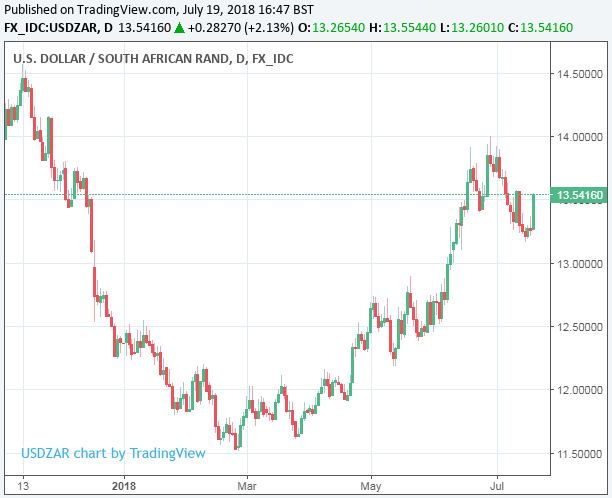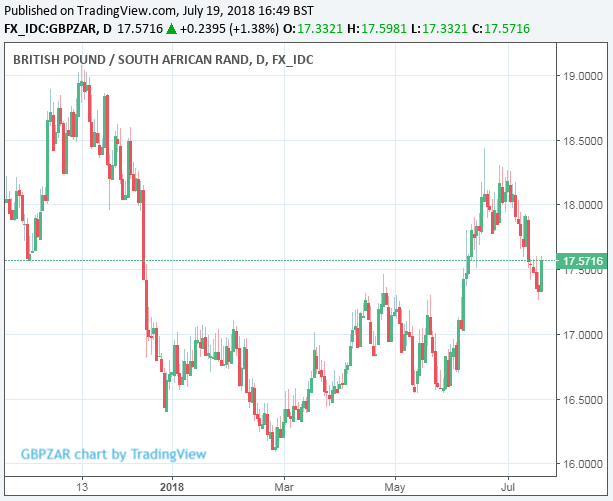More Losses for South African Rand Ahead as SARB Gives Little Hint of Desire to Raise Interest Rates
- Written by: James Skinner
- ZAR weakens amid latest USD rally, following SARB decision.
- FX analysts forecast further losses in the Rand.
- SARB rates to remain at 6.5% given fragile domestic economic conditions.

© Adobe Stock
The South African Rand weakened against all major currencies Thursday amid a renewed leg higher by the US Dollar and as traders responded to a South African Reserve Bank interest rate statement that gave scant assurance of any policy change being on the horizon.
South Africa's central bank held its main interest rate steady at 6.5% following the July meeting of rate setters, as was expected by the market, but it fell short of providing a reassurance to markets that it would step in if the Rand continues its 2018 depreciation cycle during the months ahead.
"The MPC still assesses the stance of monetary policy to be accommodative and appropriate given the current state of the economy. However, the MPC has noted the deteriorating inflation outlook," says Lesetja Kganyago, Governor of the South African Reserve Bank, in a statement. "The MPC will continue to be vigilant and will not hesitate to act should there be second-round effects that take us significantly away from the midpoint of the inflation target range."
The SARB could indirectly intervene in the currency market by raising its interest rate if the Rand depreciation, which makes imported goods more expensive to buy, pushed the rate of consumer price inflation toward or above the top end of the 3% to 6% target range. But inflation rose less than was expected in June, increasing from 4.4% to 4.6% when economists had forecast it would come in at 4.8%.
The tame inflation number came despite South Africa's Rand dropping 9% against the Dollar and more than 5% against the Pound so far this year, The currency has actually fallen further than that in recent months, given it rose by similar measures during the first-quarter.
This price action is in part the result of international investors selling some ZAR61 billion of South African government bonds during the first half of 2018 and more than ZAR4 billion of stocks, as fears over the the economy escalated.
"Since the May MPC meeting the news on the inflation front has been mixed. Actual CPI inflation prints have been better than the SARB was expecting in May," says Paul Fage, a senior emerging market strategist at TD Securities. "On the other hand, since the May meeting the rand has weakened by about 6% against the US dollar and by about 4% on a trade-weighted basis."
Driving these fears has been unease across financial markets over President Trump's "trade war", as well as a US economy that is going from strength to strength, which has seen American bond yields rise and the Dollar emerge resurgent from the depths of a bear market this year.
This has been bad for the Rand because 45% of South African government debt is owed to foreigners, with much of it denominated in US Dollars, which means those debts are now more expensive for the fiscally challenged South African government to service.

Above: USD/ZAR rate shown at daily intervals.
The USD/ZAR rate was quoted 2.14% higher at 13.54 Thursday while the Pound-to-Rand rate was 1.41% higher at 17.58.
Other emerging market currencies, like the embattled Turkish Lira, saw only modest losses Thursday.
This suggests the Rand's weakness is the result of something specific to South Africa and the SARB announcement was the only key event in the calendar for the session.

Above: Pound-to-Rand rate shown at daily intervals.
"The SARB is unlikely to enter an aggressive rate hiking cycle, and the South African Forward Rate Agreement (FRA) curve shows the markets are not anticipating an interest rate increase. Our expected case remains that the Rand could see some minor strength this year, averaging R13.20/USD in Q3.18 and R12.70/USD in Q4.18," says Annabel Bishop, chief economist at Investec Bank. "However, the risks to the downside of a weaker domestic currency as ever remain, given that the rand is both an EM and commodity currency."
Markets care about the SARB announcement because interest rates, and speculation about them, are the raison d'être for most moves in currency markets.
Changes in interest rates, or hints of them being in the cards, are only made in response to movements in inflation but impact currencies because of the push and pull influence they have on international capital flows and their allure for short-term speculators.
Emerging market central banks, such as those in Turkey and Brazil, have already raised their interest rates in a bid to stem capital outflows and stabilise their currencies. However, the SARB has remained impervious to market pressures so far. In fact, it actually cut South African interest rates back in February.
"The growth forecast has deteriorated, and the outlook remains constrained. Demand pressures in the economy are not assessed to pose a risk to the inflation outlook," Kganyago says Thursday. "A firm commitment to credible structural policy initiatives and implementation is required to make a marked impact on employment and potential output."
One reason why the Reserve Bank of South Africa may be reluctant to raise interest rates in the short term is because of the fragile South African economy, which might not be able to withstand the pressure of even higher borrowing costs without weakening further.
South African GDP growth collapsed in the first quarter, with the economy shrinking at an annualised pace of 2.2% when markets had expected only a 0.5% contraction. This left South African economic growth at just 0.8% for the year to the end of March, far beneath the market consensus for a reading of 1.9%.
"The ZAR remains more vulnerable than other emerging market currencies, not least because of South Africa’s widening current account and fiscal deficits. Moreover, we do not believe that the central bank will hike rates in 2018. We expect the rand to trade at USD/ZAR 13.9 in three months," says Annabelle Rey, a foreign exchange analyst with the Swiss bank Julius Baer.
Advertisement
Get up to 5% more foreign exchange by using a specialist provider to get closer to the real market rate and avoid the gaping spreads charged by your bank when providing currency. Learn more here




